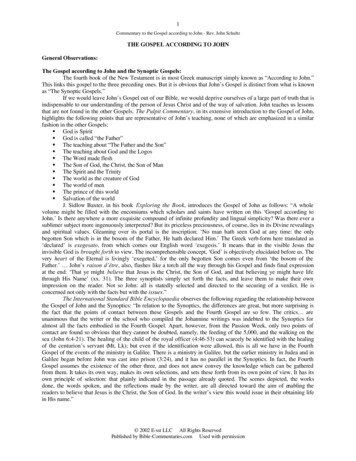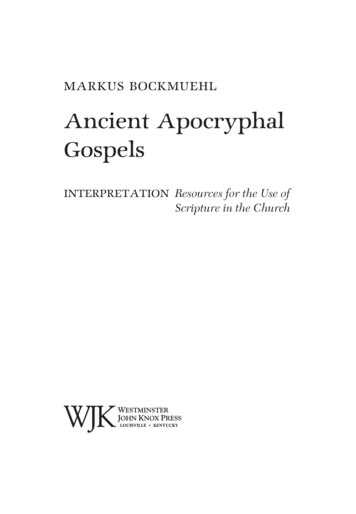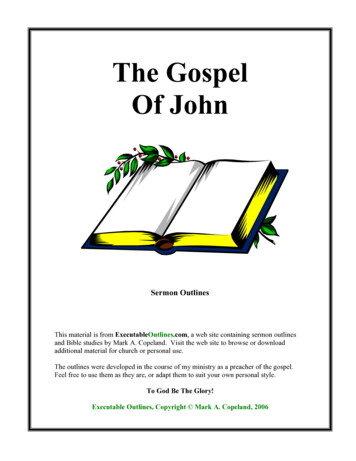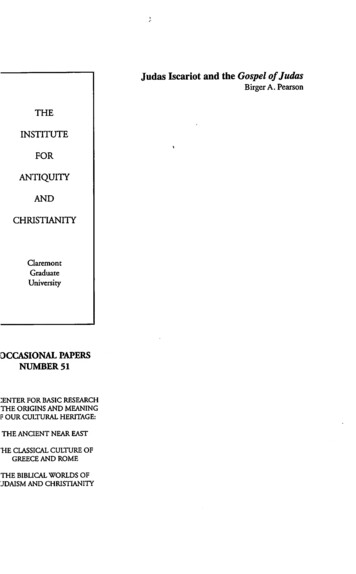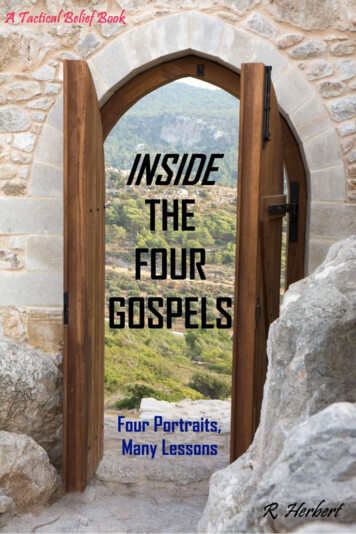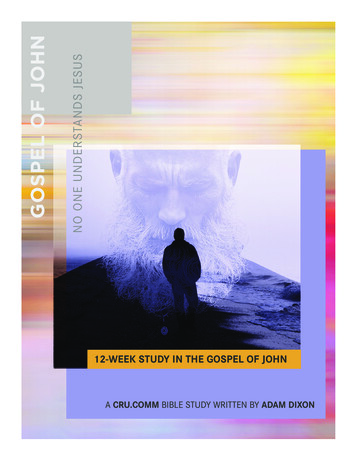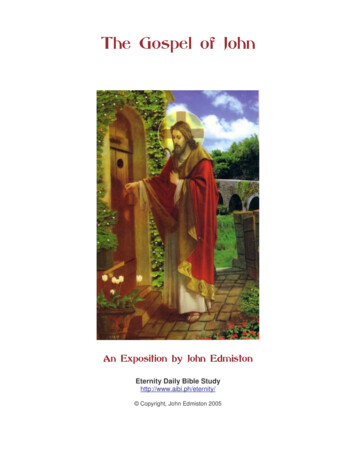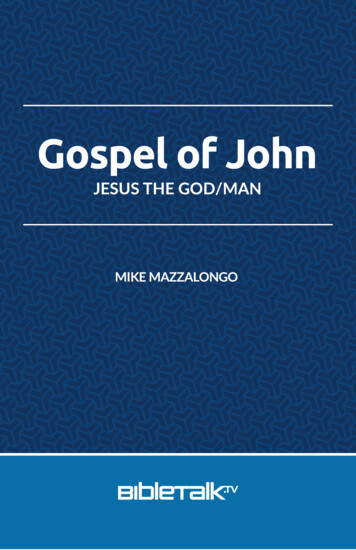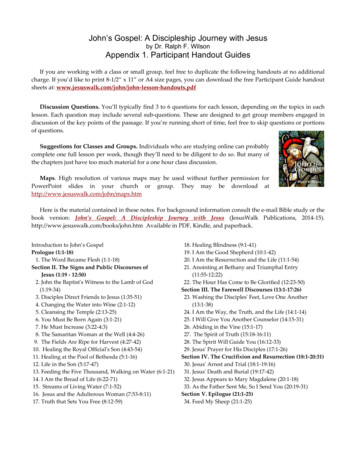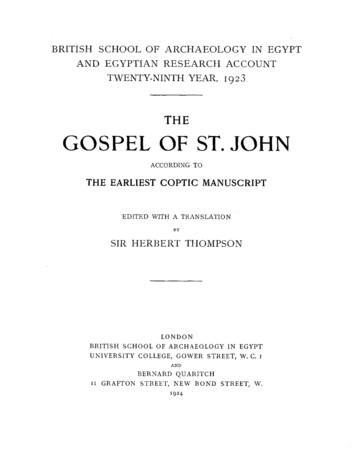
Transcription
BRITISH SCHOOL O F ARCHAEOLOGY IN EGYPTAND EGYPTIAN RESEARCH ACCOUNTTWENTY-NINTH YEAR, I 923THEGOSPEL O F ST. J O H NACCORDING TOT H E EARLIEST C O P T I C M A N U S C R I P TEDITED WITH A TRANSLATIONBYSIR HERBERT THOMPSONLONDONBRITISH S C H O O L O F ARCHAEOLOGY I N EGYPTUNIVERSITY COLLEGE, G O W E R STREET, W. C. IAND11BERNARD Q U A R I T C HGRAFTON STREET, N E W B O N D STREET, W.'924
PRINTED BYADOLFVIENNA (AUSTRIA)HOLZHAUSEN
BRITISH SCHOOL O F ARCHAEOLOGY I N EGYPTP.4TRON:F.-M.VISCOUNT ALLENBY, G.C.B., G.C.M.G.GEiVERAL C O M M I T T E E (*Executive Members)Lord ABERCROMBYHENRYBAL OURProf. R. C. BOSANQUET*Prof. J. B. BURY*SOMERSCLARKECLODDEDWARDMrs. J. W. CROWFOOTSir W. BOYDDAWRINS*Miss ECKENSTEINSir GREGORYFOSTERSir JAMES FRAZERProf. PERCYGARDNER*Prof. ERNESTGARDNER(Chairman)LORDBISHOPOF GLOUCESTERRt. Hon. Sir GEonGe T. GOLDIEMrs. J. R. GREENRt. Hon. F.-M. LORDGRENFFILLMrs. F. LL. GRIBSITHDr. A. C. HADDONDr. D. G. HOGARTH*BASILHOLMESBaron A. T O N H GEI.Prof. A. S. HUNTMrs. C. H. W. JOHNSSir HENRYMIERSJ. G. MILNEROBERTMONDProf. MONTAGUE*Miss M. A. MURRAYP. E. NEWBERRYF. W. PERC VALDr. PINCHESSir G. W. PROTHERODr. G. A. R E N E RProf. Sir F. W. RIDGEWAY*H. SEFTONJONESMrs. STRONGLady TIRARDE. TOWRYWIIYTEHonorary Director-Prof. Sir FLINDERSPETRIEHonorary Treasurer W. H. CORBETTJ.P.Honorary Secretary-LADY PETRIEAMERICAN BRANCHTHE EGYPTIAN RESEARCH ACCOUNTPresidentJAMESHENRYBREASTED,PH.DWII,LIAXJ. HOLLAND,Pa.D., Sc.D., LL.D.EDMUNDJ. JAMES,PH.D., LL.D.F. W. SHIPI.EY,PH.D.Kce-PresidentsCHARLESF. THWING,D.D., LL.D.BENIAM NIDE WHEELER,P H . . L.H.D.,,LL.D.WILLIAMCOPLEYW NSLOW,PH.D., L.H.D., LL.D.lHon. SecretaryCARROLL,PH.D.Prof. MITCHELL
PUBLICATIONSO F T H E EGYPTIAN RESEARCH ACCOUNT ANDB R I T I S H S C H O O L O F ARCHAEOLOGY I N E G Y P TI. BALLAS, 1895; by J. E. QUIBELL.(Out of print; obtainable in joint volume NAQADA ANDBALLAS, by W. M. F. PETRIE.68 plates. 20s. net.)11. THE RAMESSEUM, 1896; by J. E. QUIBELI. (Out of print.)111. EL KAB, 1897; by J. E. QIJIBELL.IV. HIERAKONPOLIS I, 1898; text by W. M. F. P. 43 plates. 20s n dV. HIERAKONPOLIS 11, 1899; by F. W. GREENand J. E. QUIBELL.39 plates (4 coloured andzo photographic).VI.VII.VIII.IX.X.XI.XII.EL ARABAH, 1900; by J. GARSTANG.40 plates. 16s. net. (Out of print.)MAHASNA, 1901; by J. GARSTANGand KURTSETHE. 43 plates. (Out of print.)TEMPLE O F THE KINGS, 1902; by A ST. GEORGECAULFEILD.24 plates. 16s. net. (Out of print.)THE OSIREION, 1903; by MARGARETA. MURRAY. 37 plates. 25s. net.SAQQARA MASTABAS I, 1904; by M. A. MURRAY;and GUROB, by L. LOAT.64 plates. 30s. net.SAQQARA MASTABAS 11, 1905; by HILDAPETRIE.( I n preparation.)HYKSOS AND ISRAELITE CITIES, 1906; by W. M. FLINDERSPETRIEand J. Gaanow DUNCAN.40 plates. 25s. net. In double volume with 94 plates. 45s. net. (This latter is out of print.)25s. net. In double volumewith rog plates. 50s. net.ATHRIBIS, 1908; by W. M. FLTNDE SPETRIE,J. H. WALKERand E. B. KNOBEL.43 plates. 25s. net.(Out of print.)MEMPHIS I, 1908; by W. M. F. PBTEIEand J. H. WALKER.54 plates. 25s. net.QURNEH, 1909; by W. M. F. PETRIEand J. H. WALKER.56 plates. (Out of print.)THE PALACE O F APRIES (MEMPHIS 11), 1909; by W. M. F L I N D EPETRIB Sand J. H. WALKER.35 plates. 25s. n d .MEYDUM AND MEMPHIS (111), 1910; by W. M. F. PETRIE,E. MACKAY,and G. W A W X I G H T .47 plates. 25s. net.HISTORICAL STUDIES, 1910. 25 plates. 25s. net. (Studies, vol. ii.)ROMAN PORTRAITS (MEMPHIS IV), 1911; by W. M. F. PETRIE. 35 plates. 25s. net.THE LABYRINTH AND GERZEH, 1911; by W. M. F. PETRIE,E. MACKAY,and G. WAINWRIGHT.52 plates. 25s. net.PORTFOLIO O F HAWARA PORTRAITS. 24 coloured plates. 50s. net.TARKHAN I AND MEMPHIS V, 1912; by W. M. F. PETRIE. 81 plates. 25s. n d .HELIOPOLIS I AND KAFR AMMAR, 1912; by W. M. F. PETRIB. 58 plates. 25s. net.RIQQEH AND MEMPHIS VI, 1913; by R. ENGELBACH,HILDAPETRIE,M. A. MURRAY, andM. F. PETRIE. 6% plates. 25s. net.TARKHAN 11, 1913; by W. M. F. PETRIE. 72 plates. 25s. net.LAHUN I, THE TREASURE, 1914; by GUYBRUNTON.23 plates (8 coloured). 63s. net.HARAGEH; by R. ENGELBACXand B. GUNN. 81 plates. 25s. net.SCARABS AND CYLINDERS, 1915; by W. M. F. PETRIE. 73 plates. 32s. net.TOOLS AND WEAPONS, 1916; by W. M. F. PETRIE. 76 plates. 35s. net.PREHISTORIC EGYPT, 1917; by W. M. F. PETRIE. 53 plates. 25s. net.CORPUS O F PREHISTORIC POTTERY; by W. M. F. PETRIE. 58 plates. 25s. net.LAHUN 11, THE PYRAMID, 1920; by W. M. F. PETRIE,G. BRUNTON,M. A. MURRAY. 75 plates. 25s. net.SEDMENT I, 1921; by W. M. F. PBTRIEand G. BRUNTON.47 plates. 25s. net.SEDMENT 11, 1921 ; by W. M. F. PETR Eand G. BRUNTON.43 plates. 25s. net.80 plates. 25s. net.THE GOSPEL O F ST. JOHN, COPTIC MS.; by Sir HERBERTTHOMPSON.TOMBS O F THE COURTIERS AND OXYRHYNCHUS. (hPress.)XIII. GIZEH AND RIFEH, 1907; by W. M. FLINDEKSPBTRIR.40 XIII.XXXIV.XXXV.XXXVI.XXXVII.W.Su6scr@tions of One Guinea for the Annual Single Volumes, or T w o GnLneas for the T w o Annual Volumes,are recezved & the Hon. Secretary, at the Edwards Library, Universi& Collcge, Gower Street, London, W.C.,where also copies of the adove works can be o6tained.
I wish to render m y grateful thanks to Sir FLINDERSPETRIEfor entrusting to m e the editing of this papyrus;D. D. and the British and Foreignto the Rev. R. KILGOURBible Society for giving m e ready access to the originalmanuscr t; and to the Rev. GEORGEHORNERwhoseelaborate editions of the Coptic text of the N e w Testamenthave so greatly lightened m y work.H. T.
CONTENTSPAGEThe Discovery of the Papyrus, by Sir FLINDERSPETRIE. . . . . . ixIntroduction :I. The manuscript. . . . . . . . . . . . . . . . . . . . . . . . . .xiz. Palaeography and d a t e . . . . . . . . . . . . . . . . . . . . .xiii3. The text . . . . . . . . . . . . . . . . . . . . . . . . . . . . . . xiii4. The dialect. . . . , . . . . . . . . . . . . . . . . . . . . . . . . xviii5. The version . . . . . . . . . . . . . . . . . . . . . . . . . . . . xxi6. Conclusion . . . . . . . . . . . . . . . . . . . . . . . . . . . . .xxviiixxxiCollation with the Greek textIThe Coptic text with interleaved plates. . . . . . . . . . . . . . . .Coptic glossary . . . . . . . . . . . . . . . . . . . . . . . . . . . . . . .45English translation53.
THE DISCOVERY O F THE PAPYRUSABOUTtmetity-seven miles south ofAsyut, halfway bcrween Cairo and Aswan the cliffs on theeast side of the Nile rise in precipices from theplain, with parallel spurs projecting into the cultivation. Near the village of Hamamieh, close to alarge wady or ravine, one of these spurs, coveredwith limestone detritus, has been used as a cemetery in Predynastic, early Dynastic and Romantimes. When Mr. Guy Brunton was clearing thisin March 1923 for the British School of Archaeology, a broken crock was found, buried 18 inchesunder the surface, in the neighbourhood of theRoman or early Coptic graves. The pot is of redpottery painted pale buff, with a decoration in blackof bands and spots, which cannot unfortunately beclosely dated. Mr. Brunton's assistant, Mr. Starkey,in emptying the dust from the pot found that itcontained a little package of papyrus wrapped inrag, and tied with thread. I t was very fragile; theouter parts were dark brown, and partly decayed.I t was therefore brought to England in the originalwrapping a s it was found, t o minimise risks intransport. The clearance of the ground was completed b y Mr. Brunton in December 1923, andbrought t o light traces of crude brick walls in theimmediate neighbourhood, with one carved limestone capital of Byzantine style. Apparently anearly church had stood here; and in the rubbishwas found a small bronze censer with chains. Thepot, the capital, and the censer will all be publishedin the forthcoming volumes on the excavations a tQau el Kebir.A t University College, on my removing the stripsof crumbling linen rag in which the papyrus lay,it was seen to be a tall narrow book of leavesstitched together, which had been sharply doubledtwice over, across the height of it. Being stitchedat the back, the leaves had skewed in folding andtlie prospect looked discouraging. I t could not beopened in the least without cracking. Damping torender it flexible was a risk, as too much moisturemould have made the two layers separate, or havereduced it to pulp. Damp cotton wool was therefore used, from which all spare moisture had beensqueezed; this was tousled as loose as possible,packed on the edges of the leaves, and the wholewrapped in a cloth. After a few days, the papyrushad absorbed enough moisture to enable it to heslightly unbent. Similar damp wool was then placedin the middle, where the folds were sharpest. Afterseveral days more, the whole mass could be flattenedout, without producing a n y fresh breaks. On separating the MS. into sheavcs, where tlie leaveswould part, the portions were interleaved in anold volume of soft paper, to dry flat. I t was thenseen that the subject was the Coptic version ofthe Gospel according t o St. John. After some daysof drying, the leaves could then be safely separated.Meanwhile, the largest*leaf was measured, andglass plates were prepared, large enough to allowof laying a border of card around each leaf, twiceas thick as the leaf, so that pressure of the glasswould not crush the papyrus. After temporarilyfastening the pairs of glasses together, tlie wholewas studied by Sir Herhert Tbompson, who rearranged any misplaced fragments, and made hisworking copy. On return to me, the fragments ofeach leaf were strapped together so that the leafcould be shifted as a whole, numbers were placedon each page according to the original pagination,and all the paper was browned to avoid contrast.Mr. Emery Walker undertook the photographingat University College, and I shifted each leaf intoposition, almost flat, and reversed it to expose eachside. The glasses were then finally bound over atthe edges. The total loss, even from the most rottenL
XTHE DISCOVEliY O F T H E I'APPRUS.and fragile parts, was not a thousandth of tlicwhole amount that was found.The condition of the papyrus showed that it hadbeen greatly worn. The first three leaves weremissing when it was folded up, and probably asmany were lost from the end. The back leaf washalf broken away; a leaf near the end had comeloose, and was laid in at about two-thirds throughthe volume, The rubbed surface of these latterleaves showed how much worn they had becomeby sliding on a reading desk. The height of theMS. indicates that it was for Church use, ratherthan a private copy. I t appears that, when too defective for regular reading, it had been set aside,and buried reverently in the cemetery.On hearing of the discovery, a member of theComrnittce of the British and Foreign Bible Societysuggested that the collection of MSS, in the libraryof that Society would be a fitting place for sucha document. The importance of it as the oldestCoptic MS. of a gospel, was also felt by othermembers of the Committee, and especially by thelibrarian, Dr. Rilgour. Among the Committee personally a contribution was made to the BritishSchool to enable the present publication to becarried out as completely as possible. The MS. isnow immediately accessible to any scholar, in thewell-lighted library of the Society in Queen Victoria St., London, where it is stored with otherimportant MSS. in a fire-proof safe. The conditionsand surroundings thus secured seem to be especiallysuitable for such a manuscript.
INTRODUCTION10 inches each way and laying them one abovethe other, each with its horizontal fibres upwards,THEPapyrus is referred to in this Introduction and then folding the whole mass in half so as toas Q. I t is a book in Codex form of which 43 leaves, form a volume of a single gathering or quire. I tor fragments thereof, are extant out of a volume must have been a clun sysort of boolc; but thewhich originally contained I O O numbered pages, method seems to have prevailed for a time whenor 50 leaves, besides in all probability one or two the codex form of book was first introduced, thoughunnumbered leaves at beginning and end.our evidence does not allow us to say that it preThe text begins at c l i . I I . zon a page numbcred 7 ceded the method of multiple quires laid sideand ends a t ch. XX. 20 on p. 96. Therefore it is by side.clear that six numbered pages, i. e. 3 leaves of textThe transition from the ancient roll form ofare missing at the beginning.manuscript (still used for reading tlie law and theW e can tell the structure of the book by the prophets in Jewish synagogues) to the codex formfibres of the papyrus. As all papyrus consists of is still somewhat obscure. I t would almost seem totwo layers of fibres at right angles to each other, have been in some way hound up with the spreadone face of a papyrus leaf presents fibres running of Christianity. A t any rate very few Christianin a horizontal direction and the other face in a literary fragments written on rolls have survived,vertical direction. These are denoted by H and V and this is the more remarlcable when me considerrespectively. In the present MS. every leaf is what tlie Jewish tradition was. The remains of thenumbered and all the leaves bearing numbers up Pastor of Hermas in Greek at Berlin arc parts ofto 50 are VH, that is, they have vertical fibres on an original roll: and the second set of "Sayingsthe recto, or first side of the leaf and horizontal of Jesus" (P. Ox. No. 654) is written on the backfibres on the verso; all leaves after 50 are HV; of a papyrus roll. In Coptic there is in Paris atherefore pages 50 and 51 are both H, and formed papyrus with four columns of extracts from thepart of one sheet originally, folded so as to make second book of Maccabees in the Achmimic dialect;a double leaf. And so we learn that the book was what remains is only about 20 inches long andmade by taking 25 square sheets of papyrus about probably it never was a complete r o l l and thesame remark applies to the papyrus fragment withAbbreviations:cxtracts from a Coptic version of the Didache reQ, tlie papyrul here edited.W, the X'ashington MS. of the Gospels. The remiining symbols cently acquired by the British M u e u m The. rollof the Greek and Latin New Testament manuscripts are theform continued to be uscd for legal and otherusual ones.documents to a much later date; but we are dealA, the Koridethi Gospels, Grez. 038, Sod. S o j o .ingonly with Christian literary texts. The codexSa. Sahidic.I.THE MANUSCRIPT')Bu, Bohairic.hf. E., Middle Egyptian.Gr, Greek.homoeot., homaeoteleutonInc., lacuna.superl., snperlinention.' L.&cnu, B. I. R A. VIII. The other fmgments in Paris publishedonginally by Bouriant and re-edited by Lacau, are written on tilebacks of old rolls which have been pnsted back to back and formedinto the leaves of a eoden.JOIO-!I.Theal. St. XXV. 2?5.l *
XI1INTRODUCTIONform of book is generally supposed to have beensuggested by the waxed tablets, which were usedeither in pairs (diptychs) or in larger numbersfastened together by cords passed through holesbored in tlie hinder wooden edges.' Such a groupof tablets seems to have been known as a codex,and tlie name was passed on to the papyrus orvellum leaves arranged in the same fdsllion. Butfor the more convenient holding together of anumber of leaves, the system above described offolding sheets of papyrus into double leaves andplacing them one inside the other was adopted insome parts of Egypt.*Very few of these single-quire books are known.There exist in Coptic:i. Berlin. Epistle I Clement (Achmimic), papyrus,end of cent. IV, edited by Car1 Schmidt (TexteU. Unters. X X X I I ) .ii. Berlin. The booli of Proverbs (Achm.), papyrus,still unpublished.iii. Berlin. A gnostic papyrus of cent. V, also unpublished (C. Schmidt, u. S., p. 7).iv. Cairo. Inst. Miss. Arch. F r a n .Epistola Apostolorum, pap. of cent.IV-V, ed. C. Schmidt, T. U.XLIII.v. Heidelberg. Acta Pauli, ed. C. Schmidt, 1914.Greek examples of single-quired books are:- i. Brit. Mus. P. OX. Nos. 2081781, pap. fragments of the Gospel of St. John of cent. 111.ii. J.P.Morgan coll., an Iliad papyrus, cent. 111-IV.iii. Stockholm. A work on chemistry.The last two instances arc quoted from Schubart,Uas Buch bei den Griechen t n dRorizer zZ, 192I .' Onp. 1 2 9 h e states that the s i eof the sheets wasgraduated, being largest in the outer ones andprogressively smaller towards the middle of thebook so as to give space for a n equal amount oftext on each leaf, and this seems to have been thecase with Q, but the condition of the edges is forthe most part too imperfect to allow of demonstration. 'Each leaf of Q measured originally about 10inches (250 mm.) in height by about 5 inches(125 mm.) in width. The text was written in a singlecolumn covering about 8'1, inches (210 mm.) by3'1, inches (85 mm.). There were from 33 to 37 lineson a page. Each page was numbered, as is alsothe case with the Acta Pauli and the EpistolaApostolorum.There was no division of the text either bychapter-numbers or by enlargement of initial letters,or by extrusion of them into the margin. The onlymark is ainserted at the ends of lines in 18 instances: their purpose is obscure, for they are notused, as in other MSS., merely to fill up shortlines; the number of letters in a line varies from11 to 25, and they are not used in specially shortlines. They have no relation to the tituli of theGospel, to the N B divisions nor the Eusebiansections, nor to any lections that we know later.Once what is apparently the same sign is placedat the beginning of a line corresponding to ourVI. I.The only punctuation is a high point; a colonseems to be used once on p. q,1. I , perhaps a mistake. The apostrophe so often found both in Greeliand Coptic early MSS. is also found here a'boveI , h, M, I , n, p, T, , seemingly to guide thereader, when reading aloud, since there is no worddivision, but the principles of its use have neveryet been adequately explained. A circumflex accent is found occasioually over I 3 when it standsfor the verb "come," as elsewhere (BM. Or.7594,Jonah; Rahlfs, Psalmenfr. p. 16), and over 0 thequalitative of lpe, doubtless t o mark them as such.The only contractions used are ItlC, XC, nNA.The superlineation for N at the end of the line isnever employed.The MS. is written in one halid throughout andall the corrections are by the hand of the writer.The scribe was not exemplary; his list of errors -M-' BmT, Das nntike Bz clrwesce, 1882, p. 95. KENYON,Palaeo' There are slight fragments of the fine cord with which theTHODCPSON,graphy of Gmek Papyri, ,899, p. 24. E. UAUNDEmaunscript was sewn still i n sit" on leslres 21-22, 23-24, 77-78I, trod. to Greek aird Latin Palncogmpily, 1912, p. 51.and 83-84; and there are numerous holes on the inner edges2 One cannot say that the single-quire preceded the multiple-quirecodex as the latter appears quite as early as the former, e. g. theOdyssey of John Rylands Llbr. cent. 111-IV is mulliple quire(Greek Papryi of the J. Ryl. Litr. ed. A. S. Hunt No. 53).H. I. BELLin an excellent rPsumP of the subject in Tile LibraryN. S., X. (lyog), p. 303 seq. mentions that there is an example aslate as the VIIIth cent. in the Brit. blus. among tlie Aphroditopapyri (Cat. Greek Pap. IV. No. 1419).which show that the sheets were held together, not as one wouldexpect by threads carried vertically throu,ah the centre of the sheet,but the inner asargbzs were pierced by a number of holes and thethreads carried across, 0 that when opened the pages showedthreads parsing horizontally across the backs of the leaves. Thesame arrangement of threads is seen depicted in several mosaics representing open volumes nearly contemporary with Q. Cf. WILPERT,Die r6,nischea Mosaiken u,zd icfalereie, , 1916, pl. 47, 85, 89 &c.
is considerable (see next col.), and the omissions dueto scribal error are unduly numerous, though it ispossible and even likely that some of these aredue to the scribe of his exemplar. H e occasionallycrosses out an error with a diagonal line, e. g. inV. 45, S. 37, XI. 27, XIV. 6, X V I I I 6, 36.2.PALAEOGRAPHY A N D DATETHEhandwriting bears a strong resemblance tothat of Vaticanus, allowance being made for thefact that one is on papyrus and the other on vellum.Consequently in Q there is not the same perfectregularity of letter-form that we find in R. Theprincipal points of difference are:K is usually not quite closed a t the top; in Vat.always closed. shows a tendency to squareness at the topand for the foot to be small compared with theoverhanging top. In Vat. it is a fair half-circle.M is square and very similar in both MSS. Theround X occurs twice in Q, on p. the seventh linefrom the bottom in the word MA, and on p. Gthe fourteenth line from the bottom in KOCMOC.I4 is usually a little wider than square, and whenbroad the diagonal tends to sag.Z has a marked serif at the top; in Vat. the topis quite flat.C like shows a tendency to flatness at the top.y is rather large and less regular than in Vat.(U is usually stnall and written well above theline; in Vat. on the line.Among early Coptic MSS. the hand of Q comesnearest to BM. Or. 7594 (Deut.-Jonah-Acts) and tothe Berlin Clement; of the two closer to Clement,but it is not so heavy as either of them.The complete reproduction of the papyrus rendersit unnecessary to enter into further detail.Sir Frederic Icenyon has given me an estimateof the date based on the study of photographs ofthe original; and he kindly allows me to quotefrom his letter. H e writes:"The manuscript to which the writing is mostakin is the Codex Vaticanus. There is the samesimplicity, the same rounded forms, the sameslight irregularities in length of lines (thoughthat is not peculiar to Vaticanus), and a verysimilar general appearance. The only sign of arather later date is a tendency to enlarge suchletters as y and , which becomcs more markedXin manuscripts of the fifth and later centuries.Taking therefore the second quarter of the fourthcentury as the probable date of the Va t' canu us,I should be inclined to assign the St. John tothe third quarter; though you know well thatdogmatism is entirely out of place in these matters,and that a precise assignment of dates is notpossible in dealing with manuscripts of this classand period. The hand is, however, so like thenormal Greek hands (which is not the case withmost Coptic MSS.), and is so evidently the workof a trained scribe, that one may feel more confidence in assigning a date to it than is oftenpossible with Coptic scripts."3. T H E TEXT O F THE MANUSCRIPTALLmanuscripts have peculiar readings, and theearlier the MS., usually the more numerous they are.The first task, however, is to clear out of theway those peculiarities nhich are due to the scribe.I t is not always quite easy to determine the borderline and to distinguish between errors and variants.Here follows a list of the errors, or what appearto be such:111. 21 nOYA IN z0 for IlNOyTe (v. l.?).V. 3 0 61AL5)INC for IQINE probably; the Fut.I11 is inadmissible with N.VI. 31 AY for q f .- G 4 nerpn c cyefor N C T as. eIse vIicre.VII. r MAA2 AEAA 2 z . . ABAA makes nonsenseand is omitted by all others.- 3 5 AlACnOplA.- 47 nhANA for- 49 MHU) omitted.- 5 2 OYN for ME.VIII. 1 2 qC&XE for AqCCX .- 23 OYABhA I' for ZCNABAA.4 5 X omitted after AE.IX. 7 IIENTAqT. for n NTAYT.- 25 oYA omitted before ANAK zO.- 40 A N A N A N for ANAN, but conceivably thereis conflation here, as three Sa MSS. readAN alone, and the scribe may have takenthe final A N to be S a ON.X. g 21TOOTq for 21TOOT.- TC KO for T6KO.- 32 N A N O Yfor G N N O Y O Y .- 3 3 OyC for X E y A ?- 38 E(S)AT8 for C U)ATCTN.F XANA.-
XIVXI.-INTROE2 T6g335153- 55X I I . 26XIV. 21omitted after h e .IV-V1becomes a problem, which will hardly beNWNCY for qNGy.answered until we know considerably more of theAYW z0 should be deleted.early history of tlie N. 1'.text than m do as yet.The peculiar readings (scribal errors beingomitted as well as the more important omissions, vhicliare included in the list of omissions, belowp. XV-XVII) are:-E omitted before napx.2; for XIN.EBOA omitted before N T x u ) A .NHEI omitted after ?; IAKONI (v. l.?).WAAPH2 (Fut. III), error for Fut. 11 orCircumstantial (cf. V. 3 0 above). Sa hasETZAP62 o r'r,pwv.- - NAElNE for MhElE.-23 N O Y M Afor NOYMA.25 EClU)AXOOY for AEIXOOY.XV. 7 bq ](l)i16 for q N A y . (dialect? cf. XVI.20).- 10 T h r X n t l for l ' q r n t l .XvI. 4 M n O y X 0 0 Y for MRIXOOY.- 7 [ IXW], if correct reading, probablyerror for 6 E l X W .- 27 MpPlTq for MppIT.Next follows a list of readings peculiar to Q.These frequently may be a mere error of the scribewho heedlessly writes .i;p. ic for L E Fa,b r i ;for a3:ci;&C.,or vice versa. But many readings, once "peculiar," have found support in later-discoveredMSS. and then at once they begin to have animportance, not on their own account necessarily,but as showing a possible connection between theMSS. containing them. A striking instance occursin Q. A curious on ission of an important verse(Jo. IX. 38) and the initial words of v. 39 first cameto light in tlie Old Latin MS. of the gospels atVerona (h) of the VIth cent, published by Biancliiniin 1749. I t is very common for a verse to be omittedand it occasioiied no remark. In 1863 Tischendorfpublished the complete text of Sinaiticus (H), cent.IV-V, which showed the same words to be inissing. H e notes that they have been added by a laterhand. In his eighth critical edition of the New Testament (1869) his note mentions the omission in Nand b and he adds that some of the words arealso missing in a later Old Latin &IS. (1) now a tBreslau. Still it was a curiosity and not yet a problem. In 1912 Prof. H. A . Sanders of Michiganpublished the first edition of the important Greekmanuscript of the gospels now at TVashington (W)of the Vth cent. and precisely tlic same words againare missing. And now Q exhibits the same phenomenon; and this omissioil occurring in two of themost important Greek uncials, and in two manuscripts of different versions, all documents of cent.11. 14 "the oxen and the sheep and the doves". . .Sa Bo om the article, with A B &c ; N hasthe article before x p u u .111, 21 "the things which he has done in thelight" instead of "done in God."IV. 10 oin "to thee" after " saith."- 42 "we believe thee not the more because"thee" is omitted elseof thy word".where.- 49 on1 the title "Lord" before "come down."One Bo MS. has the same omission.-52 om "yesterday."V. g om "and walked."- 18 "seek" instead of "were seeking."- 28 om "at this" after "marvel not".- 32 "but another beareth witness" &C. . therest omit "but:"- 44 "how then will ye be able" &c. . . . therest omit "then."VI. 24 " v h e nthe multitude therefore saw Jesuswith them, they called to his disciples,they and their boats; they went toCaph."- 25 "holv camest thou hither?" instead of"when."- 26 "that ye may see signs."- 36 "that ye will see me and ye will notbelieve;" future instead of past or present.- 46 "No one has seen the Father," probablya marginal note from I. 18 copied intothe text.- 51 iyw omitted.- 61 ncpr zsu;o2 omitted.- 63 "the words . . are spirits and life."- 68 aiwr:;J is omitted.VII. z "the Scripture saith."VIII. 14 omits "to them."- 18 omits "who sent.me."19 omits wirz r0.- 24 E M U for OUY.- 44 "the liar" (with one Bo MS.) for "thelie."- 53 "and the prophets" omitting "died.".
XVJCTION.This is not a scribe's error, as the Coptic for "and" is a preposition lit. "with,"which does not admit of a following verb.VIII. 54 " h e is God" omitting the possessivepronoun. If this is a corruption, it ismore probably from "our" than "your."IX. 4 "before the night come" instead of"cometh the night."- 2 2 "his parents therefore. .;" "therefore"is omitted elsewhere.- 35 "believe" (imperative) instead of "believest thou ?."X. 15 "my father."-- 21 "are saying" for "were saying."- 27 " b u t they follow me" for "and."also in v. 39.XI. 3 om "Lord"- 13 "but Jesus speaks" present instead ofperfect.- 26 "believest thou me?" instead of "this."- 31 "to weep" instead of "in order that shemay weep there."- 57 "for the chief priests &C." instead of"but."XII. 13 om "Osanna."- 26 "the place to which I am going" for"in which I am."- 28 "I glorify" for "I glorified."42 om 5pw; p n o i .XIII. 28 add "with him " after r. avaxErlxvwv.XIV. 10 add "me" after ,, believest."21 "this commandment" instead of "mycommandments."- 24 "my Father" for "the F."XVI. 2 "and they put you out of the synagogue," joining it to the preceding words.Bo has "if they put" &C.,but S a followsG r i n beginning a new sentence.- 13 "of truth" omitted after "Spirit," probably a scribe's error as the words arepresent in XIV. 17, XV. 26.- 19 "why" instead of "concerning this."- 23 "ye will not ask of me" omitting "anything."XVII. 10 "I receive glory" present instead ofperfect tense-perhapsa difference ofrendering rather than of reading.- 12 "vill perish" future instead of preterite.XVIII. 5 "was standing" omitting "with them."- 6 "they fell backwards upon the earth"omitting ai;r,i,Oa .- 19 "the doctrine" for "his doctrine.". .XVIII. 23- 35- 37XIX. 3-6-26XX.20-26-27"but" omitted before "if well!'"thy chief priests.""it is thou who sayest, Art thou a Icing?.""giving hirn blows on his face.""the officers and the chief priests "order."whom Jesus loved.""the disciples rejoiced" omitting conjunctive particle."he saidtherefore againunto them, Peaceunto you.""bring thy finger to these places."OhllSS1ONs may be divided according to whetherthey are due to the failings of the scribe or not.The former class may be divided into those whichare due to what is called homoeoteleuton, arisingfrom the eye catching a similar group of letters intwo adjacent spots and passing unconsciously fromthe one to the other, and those which are not dueto this
seen that the subject was the Coptic version of the Gospel according to St. John. After some days of drying, the leaves could then be safely separated. Meanwhile, the largest*leaf was measured, and glass plates were prepared, large enough to
